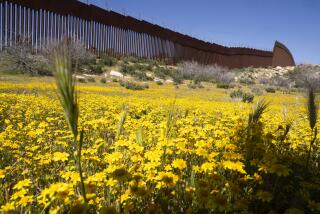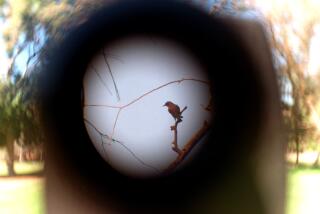91% of migratory birds face peril on their journeys, study says
- Share via
The world’s migrating birds may be in big trouble. A new study that compared the routes of 1,451 migratory bird species with the protections afforded them in different countries around the world has found that 91% of them have inadequate protected areas for at least part of their annual cycles.
The findings, published in the journal Science, show in stark detail the plight of the world’s long-distance fliers and reveal the extent to which nations will have to work together to solve it.
“This sort of analysis is a wake-up call for us to really do a much better [job of] understanding where birds are” at all times of the year, said Peter Marra, head of the Smithsonian Migratory Bird Center in Washington, D.C.
Fully understanding their annual cycle, including the locations of their breeding grounds, wintering grounds and stopover points, is key to their conservation, added Marra, who was not an author of the study.
Migrating birds, who cross continents to find warmer climes during the winter months, have fascinated humans for thousands of years of recorded history. In recent decades, scientists have been able to track them with satellites to learn the true extent of their epic seasonal voyages and have equipped them with sensors to learn sensors to learn their secrets of flight.
“I’m really fascinated by migratory birds; I just find them so interesting — these tiny little creatures that can fly across oceans, and some of them can even fly farther than a jumbo jet,” said lead author Claire Runge, a conservation scientist now at UC Santa Barbara. “There’s a bar-tailed godwit called E7, and she flew over 11,000 kilometers in a single flight.... So it’s pretty astounding that a tiny bird can do that.”
Bar-tailed godwits aren’t the only impressive fliers out there. Arctic terns, for example, “fly the equivalent of the distance to the moon and back three times during their lives,” the paper’s authors wrote.
In addition to being awe-inspiring, these birds play an important role in pest regulation, pollination and dispersing seeds across globe, according to the Food and Agriculture Organization of the United Nations.
“Migratory species make major contributions to resource fluxes, biomass transfer, nutrient transport, predator-prey interactions, and food-web structure within and among ecosystems, and play an important role in human culture,” Runge and her coauthors wrote.
But migration is a grueling and risky endeavor — birds lose a major chunk of their body weight along the journey, and many of them die. A successful journey relies on there being key stopping points along the route so the birds can rest and refuel.
Migration is like a chain, with each stopping point forming a connecting link. But as humans continue encroaching on the natural environment, they break individual links and increase the risk that the fragile chain of migration will break.
The damage is already showing, the scientists pointed out.
“More than half of migratory birds across all major flyways have declined over the past 30 years,” the authors wrote.
To get a handle on the state of migrating birds today, researchers, led by a University of Queensland in Australia team, overlaid maps of protected areas onto global bird distribution maps to see where the gaps in coverage were.
As it turns out, there were a lot.
“We show that just 9% of 1,451 migratory birds are adequately covered by protected areas across all stages of their annual cycle, in comparison with 45% of nonmigratory birds,” the study authors wrote. “This discrepancy is driven by protected area placement that does not cover the full annual cycle of migratory species, indicating that global efforts toward coordinated conservation planning for migrants are yet to bear fruit.”
Those migrating birds that are already under threat don’t seem to be getting much help, either. The red-spectacled amazon, a Brazilian migratory parrot, is officially classified as vulnerable on the International Union for Conservation of Nature Red List of Threatened Species. And yet less than 4% of its distribution occurs in protected areas in Brazil.
Overall, less than 3% of threatened migratory bird species have enough protected area coverage across their annual cycle, the study authors found.
“Filling the protection gaps for such species throughout their annual cycle is necessary for their conservation,” they wrote.
Some regions were worse than others, with countries in North Africa and Central Asia having particularly low levels of protection for migrating birds in the area.
Unlike birds that stick to one habitat, migrating birds typically rely on two or three locations that lie in very distant countries. Even though one country might have the right protections in place for a given species, the next country in the birds’ path might not.
A case in point: Germany.
“Germany meets targets for protected area coverage for more than 98% of migratory bird species occurring within its borders, but less than 13% of Germany’s migrants are adequately protected across their global range,” the authors wrote.
If the decline in migrating bird species is to be stopped, the study authors concluded, then nations around the world must cooperate more effectively across their borders to map out adequate protections for migratory birds.
Even more could be done within each nation’s borders, Marra added.
“I don’t think we’re ever going to be able to protect all the habitat out there,” Marra said. “But there are other forms of protection that I think we need to be working toward.”
Marra pointed to a need to make all kinds of private urban areas, not just protected habitats in public lands, suitable for migrating birds. That may mean planting native plants or removing predators, such as cats, from the area.
“I’m sure there are blackpoll warblers every fall and every spring that go through the White House lawn,” which is part of a national park, he said. “The White House has lots of great habitat, and that’s a very important thing.”
Follow @aminawrite on Twitter for more science news.
ALSO
Treatment for high cholesterol is widely neglected
Pesticides as bad for kids’ lungs as cigarette smoke, study says
Smartphones and the Internet are eating our TV time, Nielsen says







